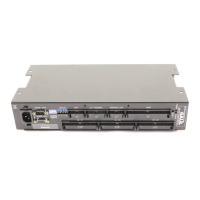DMC-1500 Chapter 4 Communication • 33
Chapter 4 Communication
Introduction
The DMC-1500 has two RS232 ports. The main port is the data set and the auxiliary port is the data
term. The main port can be configured through the switches on the front panel, and the auxiliary port
can be configured with the software command CC. The auxiliary port can either be configured as a
general port or for daisy-chain communications. The auxiliary port configuration can be saved using
the Burn (BN) instruction. The RS232 ports also have a clock synchronizing line that allows
synchronization of motion on more than one controller.
RS232 Ports
The RS232 pin-out description for the main and auxiliary port is given below. Note, the auxiliary port
is essentially the same as the main port except inputs and outputs are reversed. The DMC-1500 may
also be configured by the factory for RS422. These pin-outs are also listed below.
Note: If you are connecting the RS232 auxiliary port to a terminal or any device which is a
DATATERM, it is necessary to use a connector adapter, which changes a dataterm to a dataset . This
cable is also known as a 'null' modem cable.
RS232 - Main Port {P1} DATATERM
1 CTS - output 6 CTS - output
2 Transmit Data - output 7 RTS - input
3 Receive Data - input 8 CTS - output
4 RTS - input 9 No connect (Can be connected to +5V or sample clock with jumpers)
5 Ground
RS232 - Auxiliary Port {P2} DATASET
1 CTS - input 6 CTS - input
2 Transmit Data - input 7 RTS - output
3 Receive Data - output 8 CTS - input
4 RTS - output 9 5V (Can be disconnected or connected to sample clock with jumpers)
5 Ground
*RS422 - Main Port {P1}
1 CTS - output 6 CTS+ output
2 Transmit Data - output 7 Transmit+ output

